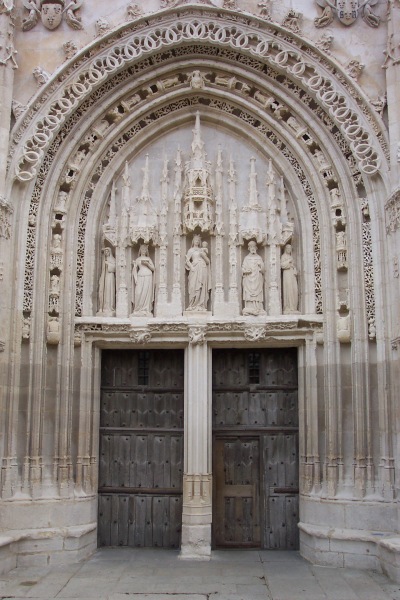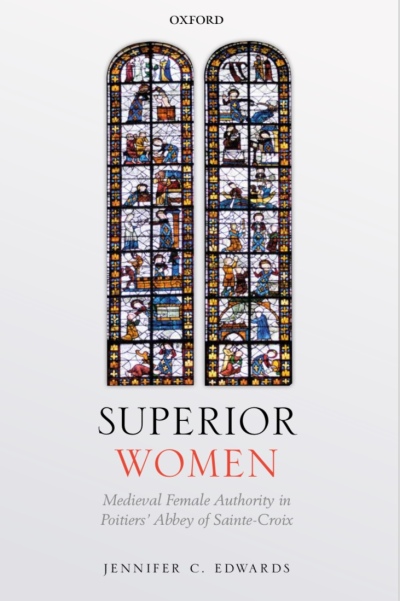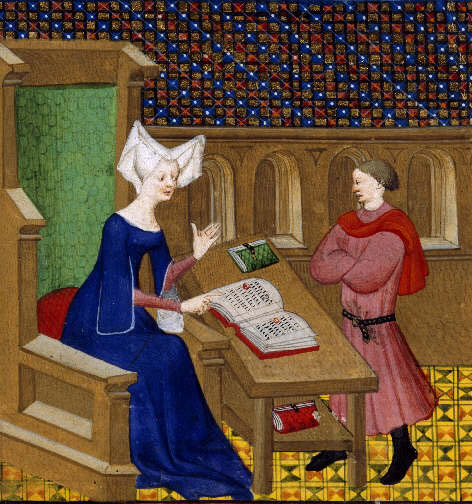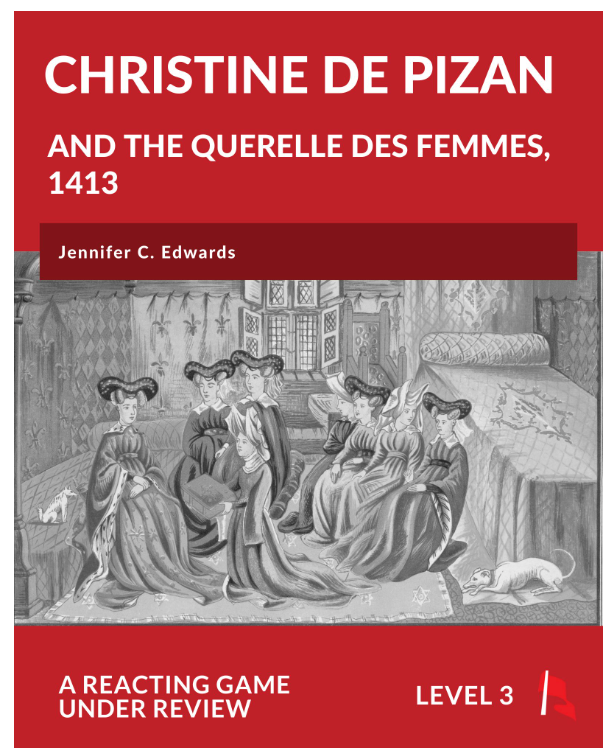Superior Women: Medieval Female Authority in Poitiers’ Abbey of Sainte-Croix (Oxford: Oxford University Press, 2019).
Superior Women examines the claims of abbesses heading the monastery of Sainte-Croix in Poitiers, France to extensive authority over nine hundred years, between the abbey’s sixth-century foundation and its sixteenth-century reform. I argue that these women succeeded in protecting their privileges by nurturing relationships with such male officials as the pope, king, and local bishops, men who are traditionally believed to have undermined female monastic authority. This argument reevaluates the current assumption that women’s position in the church dramatically declined during the Middle Ages, and that the decline was due to a male assault on female authority. Superior Women instead demonstrates consistent and long-lasting partnering between Sainte-Croix’s abbesses and male officials. By following these relationships over such a long period, I am able to reveal patterns in the abbesses’ strategies, as they carefully maintained archives documenting privileges that would motivate and encourage hierarchical male elites to support female monastic authority.
Holy Healing: Saints and Leprosy in the Middle Ages
My second book project, “Holy Healing: Saints and Leprosy in the Middle Ages” explores why medieval saints’ cults often mentioned leprosy but rarely depicted healings of the disease, and why cults attributed their few miraculous cures of leprosy exclusively to male saints. My approach newly identifies a gendered division of holy labor that forces us to revise ideas about both healing and faith during the Middle Ages. While scholars have assumed that petitioners sought from saints primarily miracles eradicating disease, this project demonstrates that medieval people valued stories about saints, particularly female saints, who offered more labor-intensive palliative care when it came to leprosy, even over the quicker miracle. As a result, “Holy Healing” offers a critical new understanding of sanctity, healing, and gender that can help us better understand the needs of people suffering from disease, and their demands on religious and medical communities.
Medieval records of saints’ holy deeds commonly depict the saints miraculously mending limbs, curing diseases, and even restoring life to the dead. In these texts, nothing was beyond the miraculous ability of saints as conduits of divine power. Leprosy, a disabling disease that afflicted Europeans in large numbers during the Middle Ages, was a major concern of medieval saints and featured regularly in their biographies and miracle tales. In the descriptions of male saints, leprosy received the usual treatment: holy men offered miraculous cures that eradicated the illness and its effects, restoring the leprosy patient to a whole, healthy body. Female saints’ holy stories take a different approach, however. Holy women often offered charitable care to those suffering from leprosy: they bathed, fed, soothed, applied ointment, and housed leprosy patients. Yet, female saints almost never cured leprosy, despite encountering the disease frequently, and despite a common ability to cure other diseases and even death as described in the same records.
This project grew out of research for Superior Women: Medieval Female Authority in Poitiers’ Abbey of Sainte-Croix (Oxford, 2019), about religious women’s well-supported claims to authority over 900 years in the abbey of Sainte-Croix, Poitiers. The abbey’s sixth-century foundress, Saint Radegund, encountered a group of leprosy patients and offered them hospitality: she washed their skin, rubbed ointment into their sores, and kissed their faces. Radegund’s attendants worried that she would be ostracized for her attention to leprosy patients, but her willingness to embrace those suffering the disease and offer them care without concern for herself instead demonstrated Radegund’s holiness as a model for the community. Yet, she did not cure the disease. Such a cure was not beyond her abilities: Radegund’s miraculous intercessions brought the dead back to life. Now I am expanding this project to look beyond Radegund’s holy impact, to the role of leprosy in European saints’ cults more generally. Saints Thomas Becket and William, for example, healed many petitioners of leprosy. At their shrines in Canterbury and York, miracle tales advertised the saints’ power, the patient’s healed body, and the shrines’ position as a site of dozens of miracles curing leprosy. This project examines this tension between cure and care and why medieval European Christians had different expectations for the treatment of leprosy by their holy men and women.
Leprosy was a major disease that afflicted communities throughout Europe during the Middle Ages. Known today for its pathogen, Mycobacterium leprae, or as “Hansen’s Disease” to ease its stigma, leprosy plagues its victims with disfigurement and disability. The disease varies and sufferers might experience few or all of dozens of symptoms, at a rapid or slow pace. Cemetery evidence suggests that leprosy is an ancient disease that infected medieval Europeans in significant numbers and without a medical cure. Biblical depictions of leprosy have encouraged historians to believe that Europeans feared leprosy but, in truth, medieval Christians offered extensive charity to people diagnosed with leprosy, demonstrating sanctity, charity, and communal caring. This might offer one explanation for why female saints offered only care to leprosy patients: such holy women provided an example to the community of how to treat a large number of sick Christians noticeably suffering among them from a disease that had no earthly cure. The difficulty of curing the disease also offers an explanation for why male saints worked miracles: doing the impossible displayed the superiority of God’s holy power. The project will pursue further understanding of these issues in the medieval spiritual economy, as well as probe the question of why saints’ cults divided these approaches by gender. Doing so will help us to understand faith and medicine in the Middle Ages and the roles of men and women in medieval healing communities.
Saints’ biographies and miracle tales are useful sources of information about health, disease, and healing in the Middle Ages, but scholars of medicine have not fully attended to the role of saints as medical workers. Medieval people valued the medical interventions of saints as much as those of secular medical professionals. Saints’ palliative care was equal to that found in hospitals, yet saints also offered the promise of divine intervention for the gravest of diseases or injuries. While the miraculous cures of male saints eradicated the disease and any threat it contained, women saints’ holy care emphasized their charitable willingness to endanger themselves for the benefit of the community. Holy women’s work in feeding, bathing, and offering ointments to leprosy patients replicated the best medical care available in the Middle Ages, since patients who stayed clean, dry, warm, and well nourished could slow leprosy’s progress. Medieval Europeans, I argue, placed saints on a spectrum of medical work, noting that women such as Saints Catherine, Elizabeth, and Angela of Foligno were willing to bathe, nourish, and tend wounds with no expectation of payment. Medieval hospitals attached to monasteries or other religious houses offered holy men and women further opportunity to display their charity and devotion to God through caring for the sick. Several saints’ miracles tell of miraculous cures that saints worked after a petitioner had exhausted all earthly interventions and finally sought the most expert physician possible: God, working through his saints. Medieval Europeans respected saints, both male and female, as holy medical workers able to provide palliative care and miraculous cure to those who sought their aid.
“Holy Healing” will have five chapters:
- Chapter 1: Saints as Medical Workers
- Chapter 2: Women Who Care and Men Who Cure: Gender Dynamics in Holy Healing
- Chapter 3: The Leper’s Kiss and the Disappearing Leper: Hagiographical Tropes of Healing
- Chapter 4: Becoming Leprous
- Chapter 5: A Holy Arms Race: Leprosy Miracles in the Canonizations of William of York and Thomas Becket
Christine de Pisan and the Querelle des Femmes, a Reacting to the Past game in development (level 3 as of 2023).
This is a Reacting to the Past game, a pedagogy developed at Barnard University to create immersion scenario role-playing “games” based on historical debates. Students take on roles in thedebate, read documents from the time, develop their characters, and attempt to solve real historical problems together. With Querelle, I am developing a new game focused on the debate Christine de Pisan engaged in about the fourteenth-century poem Roman de la Rose and its anti-feminism. Christine debated about a half dozen contemporary scholars in and around the French court about issues such as female power, competence, and authority, issues I discussed in my first book. The debate had real-world applications, as the king of France at the time, Charles V, had occasional bouts of madness that required his wife, Isabeau, to rule as regent, and because the Hundred Years War was in an active phase that included, at the end of Christine’s life, the efforts of Joan of Arc. Through this debate Christine came to write a book defending women’s abilities, The Book of the City of Ladies, which she dedicated to Isabeau and which became a fourteenth-century “bestseller,” as well as a poem praising both Joan of Arc and Isabeau. The game is well suited for classes in History, Women’s Studies, French, Political Science, and Medieval Studies. It includes a student gamebook with primary sources, instructor manual, and more than thirty roles for students to play, about 200,000 words all together. In August 2023 the Reacting Editorial Board advanced the game to Level 3 and included it on the Reacting Consortium website for download by instructors to play in their courses. Level 5 is print publication.
A Global Renaissance?: Cultural “Rebirths” Around the World, 800-1000
This is a book-length examination of global cultural movements around the ninth and tenth centuries, such as in Western Europe, Byzantium, China, and the Islamicate world. Teaching the world history survey I became intrigued that many parts of Europe, Asia, and Africa had a robust cultural and intellectual movement around the same time as the Carolingian Renaissance that I knew so well as a medievalist. In this survey I contextualize these movements and examine their features. Currently the book includes the Macedonian Renaissance in Byzantium; the Islamic Golden Age in Baghdad, al-Andalus, and Cairo; the Tang golden period centered in Chang’an; the Heian period in Japan; the Carolingian and Ottonian Renaissances in Europe; the Ancestral Puebloans’ Golden Age; and the Mataram Kingdom in Java.




